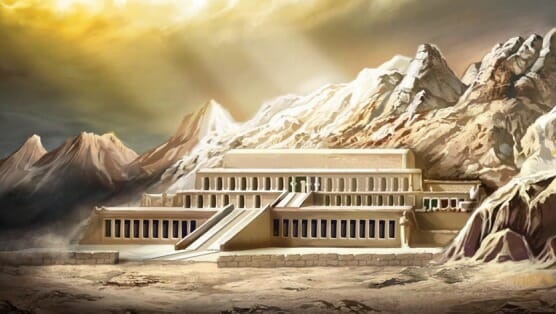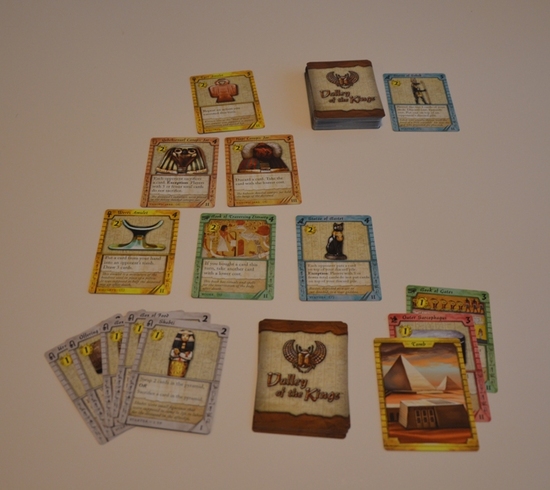
Deckbuilding games have seen a big surge in popularity thanks to the runaway success of Donald X. Vaccarino’s Dominion, the first deckbuilder to become a mainstream hit and achieve some currency even outside the niche of serious boardgamers. Dominion’s key selling point was its low barrier to entry—unlike deckbuilders that required knowledge of the cards in the deck, like Race for the Galaxy or Android: Netrunner, the available cards in a game of Dominion are visible to all players from the start, and the cards in the base set are all simple to understand and use.
Tom Cleaver’s Valley of the Kings begins with a similar structure to Dominion—each player begins with the same set of ten cards, shuffles them and draws five for his initial hand—but employs a few structural changes to distinguish it from other deckbuilders, adding a layer of complexity that also benefits players who are familiar with the cards that are coming later in the deck. That reduces its accessibility to new or younger players, and I’m not sure the gain in strategy and difficulty is sufficient for a positive payoff.
Each card in Valley of the Kings has both a monetary value for the purchase of other cards and an action associated with it. On each turn, a player may buy as many cards as s/he is able to buy, and/or take as many actions as s/he wishes, but each card can only be used for one of those two purposes on a turn—you can’t use the action on a card and then use the same card as currency to buy something else. The cards available for purchase are arrayed in a six-card “pyramid” on the table, with a row of three cards on the bottom that are immediately available, with the other cards “crumbling” down to fill in open spaces. Swapping cards around the pyramid isn’t that difficult, and many card actions allow the purchase of the three cards in the top two rows of the pyramid as well.
The pyramid is refilled from the deck of 56 cards, which itself is divided into two phases of cards. Those are individually shuffled and then placed in a single stack, phase two cards first followed by phase three, with card values, prices and action powers all increasing as the game progresses. On a player’s turn, s/he must buy a card from the pyramid or choose one of the three cards on the bottom row to trash, forcing the pyramid to crumble anyway. That forces the game to keep progressing to its finish, which occurs when the stack and pyramid are exhausted and every player has had the same number of turns, which will run 20-24 turns for a two-player game and as few as 10-12 in a four-player game.
The main twist in Valley of the Kings comes in the scoring: The cards you hold are only scored if you “entomb” them by removing them from your deck and placing them under your Tomb card. You may entomb one card from your hand for free each turn, and there are many cards that allow the entombment of other cards subject to certain conditions. The ten starter cards each player receives at the start of the game are worth a single point a piece if entombed. Among the other 56 cards in the deck are six unique artifacts, worth from 2 to 5 points apiece in the final scoring, as well as five different sets of cards that are scored exponentially when entombed. A player receives points equal to the square of the number of distinct set members in his tomb. For example, there are six different Book cards (with multiple copies of each in the deck); a player who has entombed four different Book cards gets 16 points, with no additional points for entombing a second copy of a Book card.
The key strategic decision on each turn is whether to entomb a valuable card or retain it for its purchasing power for at least one more turn. Once entombed, a card is permanently removed from a player’s deck, but is available for scoring at the end of the game. (There are some action cards that allow for the swapping of a hand card with one in the player’s tomb.) Entombing too many valuable cards early can leave a player with too little purchasing power later in the game, when most cards carry prices of six coins or higher—that is, more than a player can purchase with a hand comprising only single-coin starter cards. Waiting too long to entomb cards can leave valuable points on the table, because what’s left in your deck is worthless at game-end.
In Dominion’s base set, one of the most popular and controversial strategies is the Chapel plan, where the player uses the Chapel to trash less valuable Estate and Copper cards, maintaining a lean deck that ensures that any hand of five cards contains mostly higher-value Silver and Gold cards. Valley of the Kings doesn’t make trashing cards that simple, but there are opportunities to sacrifice (trash) or entomb cards across the game, and it appears that getting rid of as many of those initial ten cards, each of which has a buying power of one with an action of limited utility, as possible is a strictly superior strategy to any other. This increases your buying power with each hand, which in turn makes it easier to entomb a card on each turn without eliminating your ability to buy a more expensive card from the pyramid later in the game.
One hidden strength of Valley of the Kings is its sheer portability—the game itself is just a deck of 104 cards, including four Tomb cards and four reference cards showing the rules in summary form, so you can take the little box, which is only 4” by 5.5” wide and 1.5” thick, anywhere, or just throw a rubber band around the deck. As much as I love sophisticated, complex games, most of them are too big or have too many parts to bring on a family trip, a problem that Valley of the Kings avoids.
Valley of the Kings is recommended for players ages 14 and up, and my 8-year-old daughter who enjoys mild strategy games had a hard time balancing the entomb/buy decisions enough to rack up enough points to hang with the adults in the final scoring. In our experience, games ran up to 40 minutes for a three-person game and about 25-30 for a two-person game. Winning scores ran into the 50s for a two-player game and as high as the low 40s for a three-player game. Replay value is moderate, as the cards in the deck don’t change, but the random order within each phase and the rapid flow of cards through the pyramid provides some game-to-game variety. It’s worth the investment if you enjoy the feel of Dominion but want a game with different tactics and a slightly faster pace, without jumping to the hypercomplexity of deckbuilders like Android: Netrunner.
Keith Law is a senior baseball writer for ESPN.com and an analyst on ESPN’s Baseball Tonight. You can read his baseball content at search.espn.go.com/keith-law and his personal blog the dish, covering games, literature, and more, at meadowparty.com/blog.
